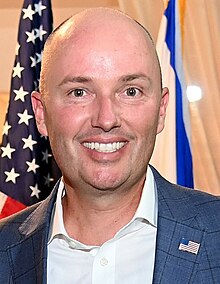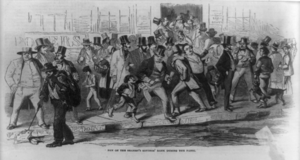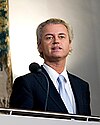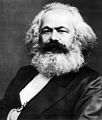Portal:Politics
| Main | Topics and categories | Tasks and projects |
The Politics portal
Politics (from Ancient Greek πολιτικά (politiká) 'affairs of the cities') is the set of activities that are associated with making decisions in groups, or other forms of power relations among individuals, such as the distribution of resources or status. The branch of social science that studies politics and government is referred to as political science.
It may be used positively in the context of a "political solution" which is compromising and non-violent, or descriptively as "the art or science of government", but also often carries a negative connotation. The concept has been defined in various ways, and different approaches have fundamentally differing views on whether it should be used extensively or in a limited way, empirically or normatively, and on whether conflict or co-operation is more essential to it.
A variety of methods are deployed in politics, which include promoting one's own political views among people, negotiation with other political subjects, making laws, and exercising internal and external force, including warfare against adversaries. Politics is exercised on a wide range of social levels, from clans and tribes of traditional societies, through modern local governments, companies and institutions up to sovereign states, to the international level.
In modern nation states, people often form political parties to represent their ideas. Members of a party often agree to take the same position on many issues and agree to support the same changes to law and the same leaders. An election is usually a competition between different parties.
A political system is a framework which defines acceptable political methods within a society. The history of political thought can be traced back to early antiquity, with seminal works such as Plato's Republic, Aristotle's Politics, Confucius's political manuscripts and Chanakya's Arthashastra. (Full article...)
Selected article
The Referendum Party was a Eurosceptic, single-issue political party that was active in the United Kingdom from 1994 to 1997. The party's sole objective was for a referendum to be held on the nature of the UK's membership of the European Union (EU). Specifically, it called for a referendum on whether the British electorate wanted to be part of a federal European state or to revert to being a sovereign nation that was part of a European free-trade bloc without wider political functions.
Featured picture

Located in Victoria, British Columbia, Canada, and officially opened in 1898 with a 500 feet (150 m) long facade, central dome, two end pavilions, and a gold-covered statue of Captain George Vancouver, the British Columbia Parliament Buildings are home to the Legislative Assembly of British Columbia.
The Soviet Union was established in 1922. However, the country's first constitution was only adopted in 1924. Before that time, the 1918 Constitution of the Russian Soviet Federative Socialist Republic functioned as the constitution of the USSR. According to the 1918 Constitution, the All-Russian Central Executive Committee (CEC), whose chairman was head of state, had the power to determine what matters of income and taxation would go to the state budget and what would go to the local soviets. The CEC could also limit taxes. In periods between convocations of the Congress of Soviets the CEC held supreme power. In between sessions of the Congress of Soviets the CEC was responsible for all the affairs of the Congress of Soviets. The CEC and the Congress of Soviets was replaced by the Presidium and the Supreme Soviet respectively by several amendments to the 1936 Constitution in 1938. (Full article...)
The Song dynasty (960–1279) was an imperial dynasty of China that succeeded the period referred to as Five Dynasties and Ten Kingdoms period (907–960) and preceded the Yuan dynasty (1271–1368), which conquered the Song dynasty in 1279. The conventional division into the Northern Song dynasty (960–1127) and Southern Song dynasty (1127–1279) is created by the conquest of northern China by the Jin dynasty (1115–1234) in 1127 and the consequent shift of the capital from Bianjing (present-day Kaifeng) in the north to Lin'an (present-day Hangzhou) in the south.
Below is a complete list of emperors of the Song dynasty, including their temple names, posthumous names, given names, and era names. The dynasty was founded by Zhao Kuangyin, who became Emperor Taizu (r. 960–976) and concluded with the death of Zhao Bing (r. 1278–1279). The last emperor of the Northern Song was Emperor Qinzong (r. 1126–1127), while the first Southern Song emperor was Emperor Gaozong (r. 1127–1162). (Full article...)
ImageSize = width:1600 height:auto barincrement:15
PlotArea = top:10 bottom:30 right:100 left:20
AlignBars = early
DateFormat = yyyy
Period = from:-210 till:220
TimeAxis = orientation:horizontal
ScaleMajor = unit:year increment:10 start:-210 (Full article...)
In Missouri, the county level of government comes between those of the city and the state. Its primary responsibilities include maintaining roads, providing security, prosecuting criminals, and collecting taxes. Elected officials at this level include a sheriff, prosecuting attorney, and assessor. (Full article...)
Throughout its history, presidents have served purposes and effects including providing the NRA greater legitimacy; holders of the office have also intentionally provoked outrage and condemnation. Since the 1990s, some NRA presidents have made controversial statements such as when James W. Porter II referred to Barack Obama, whose administration he perceived as hostile to gun rights, as a "fake president" and when Charlton Heston proclaimed to gun control advocates that they could only have his firearm after taking it "from my cold, dead hands." (Full article...)

There are 67 counties in the U.S. state of Florida, which became a territory of the U.S. in 1821 with two counties complementing the provincial divisions retained as a Spanish territory, Escambia to the west and St. Johns to the east. The two counties were divided by the Suwannee River. All of the other counties were created later from these two original counties. Florida became the 27th U.S. state in 1845, and its last county was created in 1925 with the formation of Gilchrist County from a segment of Alachua County. Florida's counties are subdivisions of the state government. Florida's most populous county is Miami-Dade County, the seventh most populous county in the nation, with a population of 2,701,767 as of the 2020 census.
In 1968, counties gained the power to develop their own charters. All but two of Florida's county seats are incorporated municipalities: the exceptions are Crawfordville, county seat of rural Wakulla County, and East Naples, located outside Naples city limits in Collier County. (Full article...)
The governor of New Jersey is the head of government of New Jersey and the commander-in-chief of the state's military forces. The governor has a duty to enforce state laws and the power to either approve or veto bills passed by the New Jersey Legislature, to convene the legislature, and to grant pardons, except in cases of treason or impeachment.
The first New Jersey State Constitution, ratified in 1776, provided that a governor be elected annually by the state legislature, the members of which were selected by the several counties. Under this constitution, the governor was president of the upper house of the legislature, then called the Legislative Council. The 1844 constitution provided for a popular vote to elect the governor, who no longer presided over the upper house of the legislature, now called the Senate. The 1844 constitution also lengthened the governor's term to three years, set to start on the third Tuesday in January following an election, and barred governors from succeeding themselves. The 1947 constitution extended terms to four years, and limits governors from being elected to more than two consecutive terms, though they can run again after a third term has passed. Joseph Bloomfield, Peter Dumont Vroom, Daniel Haines, Joel Parker, Leon Abbett, and Walter Evans Edge each served two non-consecutive stints as governor while A. Harry Moore served three non-consecutive stints. Foster McGowan Voorhees, James Fairman Fielder, and Richard Codey each served two non-consecutive stints, one as acting governor and one as official governor. (Full article...)

The president of Pakistan is the head of state of the Islamic Republic of Pakistan.
The complete list of presidents of Pakistan includes the persons sworn into the office of president following the proclamation of the Islamic Republic of Pakistan in 1956. (Full article...)
Two counties were renamed after their creation. Carter County was renamed Sweetwater County on December 1, 1869. Pease County, formed in 1875, was renamed Johnson County in 1879. (Full article...)

A monarch is the head of a monarchy, a form of government in which a state is ruled by an individual who normally rules for life or until abdication, and typically inherits the throne by birth. Monarchs may be autocrats (as in all absolute monarchies) or may be ceremonial figureheads, exercising only limited or no reserve powers at all, with actual authority vested in a legislature and/or executive cabinet (as in many constitutional monarchies). In many cases, a monarch will also be linked with a state religion. Most states only have a single monarch at any given time, although a regent may rule when the monarch is a minor, not present, or otherwise incapable of ruling. Cases in which two monarchs rule simultaneously over a single state, as is the current situation in Andorra, are known as coregencies.
A variety of titles are applied in English; for example, "king" and "queen", "prince" and "princess", "grand duke" and "grand duchess", "emperor" and "empress". Although they will be addressed differently in their local languages, the names and titles in the list below have been styled using the common English equivalent. Roman numerals, used to distinguish related rulers with the same name, have been applied where typical. (Full article...)

The governor of Utah is the head of government of Utah and the commander-in-chief of its military forces. The governor has a duty to enforce state laws as well as the power to either approve or veto bills passed by the Utah Legislature. The governor may also convene the legislature on "extraordinary occasions".
The self-proclaimed State of Deseret, precursor to the organization of the Utah Territory, had only one governor, Brigham Young. Utah Territory had 15 territorial governors from its organization in 1850 until the formation of the state of Utah in 1896, appointed by the President of the United States. John W. Dawson had the shortest term of only three weeks and Brigham Young, the first territorial governor, had the longest term at seven years. (Full article...)

There have been as many as 48 recessions in the United States dating back to the Articles of Confederation, and although economists and historians dispute certain 19th-century recessions, the consensus view among economists and historians is that "The cyclical volatility of GDP and unemployment was greater before the Great Depression than it has been since the end of World War II." Cycles in the country's agricultural production, industrial production, consumption, business investment, and the health of the banking industry contribute to these declines. U.S. recessions have increasingly affected economies on a worldwide scale, especially as countries' economies become more intertwined.
The unofficial beginning and ending dates of recessions in the United States have been defined by the National Bureau of Economic Research (NBER), an American private nonprofit research organization. The NBER defines a recession as "a significant decline in economic activity spread across the economy, lasting more than two quarters which is 6 months, normally visible in real gross domestic product (GDP), real income, employment, industrial production, and wholesale-retail sales". (Full article...)
The General Secretary of the Central Committee of the Communist Party of the Soviet Union was the leader of the Communist Party of the Soviet Union (CPSU). From 1924 until the country's dissolution in 1991, the officeholder was the recognized leader of the Soviet Union. Prior to Stalin's accession, the position was not viewed as an important role in Lenin's government and previous occupants had been responsible for technical rather than political decisions.
Officially, the General Secretary solely controlled the Communist Party directly. However, since the party had a monopoly on political power, the General Secretary de facto had executive control of the Soviet government. Because of the office's ability to direct both the foreign and domestic policies of the state and preeminence over the Soviet Communist Party, it was the de facto highest office of the Soviet Union. (Full article...)
Selected quote
Selected biography
George Walker Bush (born July 6, 1946) is an American politician who served as the 43rd President of the United States from 2001 to 2009. Before that he was the 46th Governor of Texas, serving from 1995 to 2000. In a close and controversial election, Bush was elected President in 2000 as the Republican candidate, defeating Vice President Al Gore in the Electoral College. A series of terrorist attacks occurred eight months into Bush's first term as president on September 11, 2001. In response, Bush announced a global War on Terror, ordered an invasion of Afghanistan that same year and an invasion of Iraq in 2003. In addition to national security issues, Bush promoted policies on the economy, health care, education, and social security reform. Bush successfully ran for re-election against Democratic Senator John Kerry in 2004, in another relatively close election. He was a highly controversial figure internationally, with public protests occurring even during visits to close allies, such as the United Kingdom.
Did you know (auto-generated) -

- ... that Dave Barrow quit municipal politics to work at his family's insurance brokerage before becoming mayor of Richmond Hill?
- ... that Prawoto Mangkusasmito did not complete law school before the Japanese invaded because he was too busy with student and political organizations?
- ... that Jonathan Allen left journalism for politics before quitting 40 days later?
- ... that Czech television reporter and author Vladimír Škutina was arrested and imprisoned twice for his use of political satire?
- ... that Rabab Al-Kadhimi was threatened with deportation from Egypt due to the political nature of her poetry?
- ... that advertisements for Road 96 were taken down by Facebook for being too political?
More did you know...
- ...that the Japanese Farmer-Labour Party was banned just a few hours after its foundation in 1925?
- ...that Glenn Beck introduced a "Black-Robed Regiment" of pastors from various denominations during his Restoring Honor rally in 2010, and launched a news website called The Blaze three days later?
- ...that the book Targeted Killing in International Law argues support in the Western world for targeted killing increased following the September 11 attacks?
- ...that Matt Taibbi's book Griftopia has been described as a "necessary ... corrective" to the assertion that bubbles are an inevitable part of the market economy?
- ...that in the book Net.wars, author Wendy M. Grossman attributes Internet conflict in the 1990s to culture shock from an influx of users?
- ...that former California Assembly Republican Leader and California Republican Party Chair Robert W. Naylor was editor of The Stanford Daily while he was a student at Stanford University?
- ...that the New Zealand McGillicuddy Serious Party wanted to return to a medieval lifestyle and establish a monarchy based on the Scottish Jacobite line?
- ...that during the Sixth Congress of the Cuban Communist Party, Raúl Castro proposed term limits for the country's leaders?
In this month
- May 5, 2005 – A General Election in the United Kingdom sees Tony Blair's Labour government returned to office with a reduced majority of 66.
- May 14, 1948 – The Declaration of Independence of Israel is made.
- May 18, 1948 – The first Legislative Yuan of the Republic of China officially convenes in Nanking.
News and Current events
- August 11: 4 local government areas in New South Wales, Australia locked down after COVID-19 case
- August 11: Australia: AstraZeneca vaccine access expanded by Victorian government
- August 1: Australia: Victorian lockdown lifted
- July 29: Tunisia's president dismisses prime minister, suspends parliament
- July 25: Australia: Wikinews interviews Reg Kidd, mayor of the City of Orange, about COVID-19 lockdown and local government
- July 23: South Australia enters week-long lockdown to contain COVID-19 Delta variant spread
- July 21: Technological University Dublin senior lecturer Dr Lorcan Sirr speaks to Wikinews on housing market in Ireland
- July 21: Three rural councils in New South Wales, Australia enter 7-day lockdown
- July 21: Australia: Victoria lockdown extended by a week with 85 active cases recorded
- July 15: California governor signs new state budget, eligible Californians to get stimulus payments
Topics and categories
General images
Related portals
Associated Wikimedia
The following Wikimedia Foundation sister projects provide more on this subject:
-
Commons
Free media repository -
Wikibooks
Free textbooks and manuals -
Wikidata
Free knowledge base -
Wikinews
Free-content news -
Wikiquote
Collection of quotations -
Wikisource
Free-content library -
Wikiversity
Free learning tools -
Wiktionary
Dictionary and thesaurus





















































